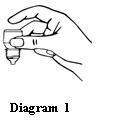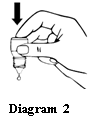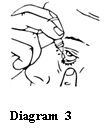IOPIDINE® EYE DROPS 0.5%
Apraclonidine hydrochloride
CONSUMER MEDICINE INFORMATION
What is in this leaflet
Please read this leaflet carefully before you use Iopidine Eye Drops.
This leaflet answers some common questions about Iopidine Eye Drops. It does not contain all of the available information. It does not take the place of talking to your doctor or pharmacist.
The information in this leaflet was last updated on the date listed on the final page. More recent information on the medicine may be available.
You should ensure that you speak to your pharmacist or doctor to obtain the most up to date information on the medicine.
You can also download the most up to date leaflet from www.novartis.com.au.
The updates may contain important information about the medicine and its use of which you should be aware.
All medicines have risks and benefits. Your doctor has weighed the expected benefits of you using Iopidine Eye Drops against the risks this medicine could have for you.
The information in this leaflet applies to Iopidine only. This information does not apply to similar products, even if they contain the same ingredients.
If you have any concerns about using this medicine, ask your doctor or pharmacist.
Keep this leaflet with the medicine.
You may need to read it again.
What Iopidine is used for
Iopidine Eye Drops are used to lower raised pressure in the eye and to treat glaucoma.
Glaucoma is usually caused by a build-up of the fluid which flows through the eye. This build up occurs because the fluid drains out of your eye more slowly than it is being pumped in. Since new fluid continues to enter the eye, joining the fluid already there,
methotrexate anemia the pressure continues to rise. This raised pressure may damage the back of the eye resulting in gradual loss of sight. Damage can progress so slowly that the person is not aware of this gradual loss of sight. Sometimes even normal eye pressure is associated with damage to the back of the eye.
There are usually no symptoms of glaucoma. The only way of knowing that you have glaucoma is to have your eye pressure, optic nerve and visual field checked by an eye specialist. If glaucoma is not treated, it can lead to serious problems, including total blindness. Untreated glaucoma is one of the most common causes of blindness.
Iopidine Eye Drops contain the active ingredient apraclonidine hydrochloride. Apraclonidine hydrochloride belongs to a class of medicines known as alpha-adrenergic agonists.
Iopidine Eye Drops are used, in conjunction with other medications, to lower raised pressure within your eyes. Iopidine Eye Drops do this by reducing the amount of fluid produced within your eyes.
Ask your doctor if you have questions about why this medicine has been prescribed for you.
Your doctor may have prescribed it for another reason.
This medicine is only available with a doctor’s prescription.
For more information about glaucoma, contact Glaucoma Australia (telephone 1800 500 880).
There is no evidence that Iopidine is addictive.
Use in Children
Iopidine Eye Drops are not recommended in children and infants due to the risk of serious side effects.
Before you use Iopidine
When you must not use it
Do not use this medicine if you:
are allergic to apraclonidine hydrochloride, clonidine, or to any of the other ingredients in Iopidine Eye Drops. These are listed at the end of this leaflet under “Product description.”
Some of the symptoms of an allergic reaction include:
Shortness of breath
Wheezing or difficulty breathing
Swelling of the face, lips, tongue or other parts of the body
Rash, itching or hives on the skin.
are currently taking any monoamine oxidase inhibitors (MAOI) which are used to treat depression.
are currently taking a tricyclic antidepressant for depression.
are currently taking any sympathomimetic medications which are used to treat asthma, severe headaches, or coughs and colds.
If you are unsure if you are taking any of these medicines ask your doctor or pharmacist.
Do not use this medicine if the expiry date printed on the pack has passed, the packaging is torn, the safety seal around the closure and neck area is broken or the bottle/packaging shows signs of tampering.
If this medicine has expired or is damaged, return to your pharmacist for disposal.
If you use this medicine after the expiry date has passed, it may not work.
If you are not sure whether you should start using Iodipine, talk to your doctor.
Before you start to use it
Tell your doctor if:
You are pregnant, or intend to become pregnant.
Iopidine is not recommended for use in pregnancy. Your doctor will discuss the possible risks and benefits of using Iopidine during pregnancy.
You are breastfeeding or intend to breastfeed.
You should stop breastfeeding while you are using this medicine as Iopidine is not recommended whilst breastfeeding.
Tell your doctor if you have, or have had, any medical conditions especially the following:
Heart problems. These include coronary heart disease (symptoms can include chest pain or tightness, breathlessness or choking), heart failure, a recent heart attack
Circulation conditions. These include Raynaud’s disease, thromboangiitis obliterans (Buerger disease) where there is inflammation and clotting of the small and medium arteries and veins of the hands and feet, poor circulation of blood in the brain.
High blood pressure
Kidney problems
Liver problems
Depression
A type of glaucoma called angle-closure or narrow-angle glaucoma.
Taking or using other medicines
Tell your doctor or pharmacist if you are taking or using other medicines, including medicines that you get without a doctor’s prescription from a pharmacy, supermarket or health food shop.
This is particularly important if you are currently using any type of beta-blocker medication, any medicine for the treatment of high blood pressure, any medicine for the treatment of a heart condition, any sedative-type medicine including alcohol and strong pain-killers, tricyclic antidepressants.
These medicines may be affected by Iopidine or may affect how well it works. You may need different amounts of your medicines, or you may need to take or use different medicines.
If you are unsure if you are taking these medicines speak to your doctor or pharmacist.
Your doctor of pharmacist have more information on medicines to be careful with or avoid while using this medicine.
How to use Iopidine
Follow all directions given to you by your doctor carefully.
They may differ from the information contained in this leaflet.
If you do not understand the instructions on the box or bottle, ask your doctor or pharmacist for help.
How much to use
The usual dose of Iopidine Eye Drops is one drop in the affected eye(s) three times each day.
Do not put Iopidine Eye Drops into your eye(s) while you are wearing soft contact lenses.
You can insert soft contact lenses 15 minutes after you have used Iopidine Eye Drops.
Do not use Iopidine Eye Drops more often than your doctor or pharmacist has told you.
After using Iopidine Eye Drops, wait at least 5 minutes before putting any other eye drops in your eyes.
This ensures that you do not wash any of the eye drops from your eyes.
It is important to use Iopidine exactly as your doctor or pharmacist has told you. If you use the drops less often than prescribed, they may not work as well and the eye problem may not improve. Using the drops more often than prescribed may not improve the eye problem any faster and may cause increased side effects.
How to use Iopidine
Follow these steps to use Iopidine Eye Drops:
1.Wash your hands well with soap and water.
2.Immediately before using a bottle for the first time, break the safety seal around the neck area and throw the loose plastic ring away.
4.Hold the bottle upside down in one hand between your thumb and middle finger (see Diagram 1).

5.Tilt you head back and look up.
6.Using your other hand, gently pull down your lower eyelid to form a pouch/pocket.
7.Place the dropper tip close to, but not touching, your eye. Release one drop into the pouch/pocket formed between your eye and eyelid by gently tapping or pressing the base of the bottle with your forefinger (see Diagrams 2 and 3).


8.Close your eye. Do not blink or rub your eye.
9.While your eye is closed, place your index finger against the inside corner of your eye and press against your nose for about two minutes.
10.This will help to stop the medicine from draining through the tear duct to the nose and throat, from where it can be absorbed into other parts of your body.
11.Replace the cap on the bottle, closing it tightly.
12.Wash your hands again with soap and water to remove any residue.
You may feel a slight burning sensation in the eye shortly after using Iopidine Eye Drops.
If this persists, or is very uncomfortable, contact your doctor or pharmacist.
Most people who use Iopidine Eye Drops will notice a whitening of the eye shortly after using the product.
Do not touch the tip of the dropper to your eye or to any other surface.
This will help to prevent your eye drops becoming dirty or contaminated.
How long to use it
Continue using your medicine for as long as your doctor tells you.
This medicine helps control your condition, but does not cure it.
If you are unsure about when, or how, to stop using Iopidine Eye Drops you should talk to your doctor.
If you forget to use Iopidine
If it is almost time for your next dose, skip the dose you missed and take your next dose when you are meant to. Otherwise, use the drops as soon as you remember and then go back to using them as you would normally.
Never take a double dose to make up for the one that you missed.
If you are not sure what to do, contact your doctor or pharmacist.
Use in older adults
There are no special warnings or precautions regarding the use of Iopidine Eye Drops in older adults.
If you use too much (overdose)
If you accidentally put too many drops in your eye(s) immediately rinse your eye(s) with warm water.
If you think that you or anyone else may have swallowed any or all of the contents of a bottle of Iopidine Eye Drops, immediately telephone your doctor or Poisons Information Centre on 13 11 26 for advice, or go to Accident and Emergency at your nearest Hospital. Do this even if there are no signs of discomfort or poisoning.
While you are using Iopidine
Things you must do
If you become pregnant while you are using Iopidine Eye Drops tell your doctor immediately.
If you are about to be started on any new medicines remind your doctor and pharmacist that you are using Iopidine Eye Drops.
Keep all your doctor’s appointments so that your progress can be checked.
Your doctor will usually ask you to return regularly to make sure that Iopidine Eye Drops are working. It is very important that you return to see your doctor when instructed.
Things you must not do
Do not use Iopidine to treat any other complaints unless your doctor tells you.
Do not give this medicine to anyone else, even if they appear to have the same condition as you.
Do not stop using Iopidine Eye Drops or lower the dose without first asking your doctor.
If you stop using your medicine your condition may worsen.
Do not let children handle Iopidine Eye Drops.
If a child accidentally swallows any of the Iopidine Eye Drops follow the instructions under the “If you use too much (overdose)” section above.
You should not drive, operate machinery or perform tasks requiring mental alertness and/or physical coordination as you may feel dizzy or tired after using Iopidine Eye Drops.
Side effects
Tell your doctor as soon as possible if you do not feel well while you are using Iopidine Eye Drops.
This medicine helps most people with glaucoma, but it may have unwanted effects in a few people. All medicines can have side effects. Sometimes they are serious, most of the time they are not. You may need medical treatment if you get some of the side effects.
Most side effects from Iopidine Eye Drops occur in, or around, the eye.
These include:
A feeling that the eye is dry or watery
Blurred vision and/or problems seeing clearly
Itchy eyes
Eye/eyelid redness
Discharge from the eye and/or crusty eyelashes
Discomfort, grittiness, irritation or pain in the eye(s)
Excessive sensitivity to bright light
Dilated pupils
Swelling to the front part of the eye
Difficult opening the eye
Eyelid swelling
Scales on or around the eyelid
Raising of the upper eyelid
Droopy eyelids
Conjunctiva (layer of skin between eyelid and eye) swelling.
It is also possible to experience an allergic-like reaction when using Iopidine Eye Drops. The allergic-like reaction may result in a redness and swelling of the eye(s), eyelid(s) and/or the areas surrounding the eye(s). The eye(s) may become watery, itchy and uncomfortable, as though something is in them.
If you think that you may be having an allergic-like reaction to Iopidine Eye Drops contact your doctor immediately.
Occasionally some people notice unwanted effects in the rest of their body as a result of using Iopidine Eye Drops. These effects may include:
Headache and/or feeling sick
Dizziness, tiredness, lack of co-ordination, fainting
Mood changes, such as depression, irritability or nervousness
Inability to sleep
Dry mouth
Sore throat and/or runny nose
Dry nose
Changes in the sensations of taste and/or smell
Chest pain
Irregular heartbeat
Wheezing, difficulty in breathing
Numbness or tingling in fingers or toes
Swelling of the face, hands or feet
Nausea and/or Constipation
Aching or painful muscles, not caused by exercise
Skin rash.
Tell your doctor or pharmacist if you notice anything that is making you feel unwell.
Other side effects not listed above may also occur in some people.
After using Iopidine
Storage
Keep Iopidine Eye Drops in a cool place where the temperature stays below 25°C. Do not freeze Iopidine Eye Drops.
Do not leave Iopidine Eye Drops or any other medicine in the bathroom, or near a sink or in other dark, warm places. Do not leave it on a window sill or in the car.
Heat and dampness can destroy some medicines.
Do not leave the top off the bottle for any length of time, to avoid contaminating the eye drops.
Keep Iopidine in a safe place where children cannot reach it.
A locked cupboard at least one-and-a-half metres above the ground is a good place to store medicines.
Disposal
Write the date on the bottle when you open the eye drops and throw out any remaining solution after four weeks.
Eye drops contain a preservative which helps prevent germs growing in the solution for the first four weeks after opening the bottle. After this time there is a greater risk that the drops may become contaminated and cause an eye infection. A new bottle should then be used.
If your doctor tells you to stop using Iopidine or it has passed its expiry date, ask your pharmacist what to do with any remaining solution.
Product description
What it looks like
Iopidine is a sterile isotonic solution supplied in Drop-Tainer® bottles of 5 mL or 10 mL.
Ingredients
Iopidine contains the active ingredient apraclonidine hydrochloride 5 mg in 1 mL (0.5%).
Iopidine also contains the inactive ingredients:
benzalkonium chloride (as a preservative)
sodium acetate
sodium chloride
purified water.
Allergens:
May contain benzoates, sulfites and hydroxybenzoates.
Supplier
Iopidine is supplied in Australia by:
Novartis Pharmaceuticals Australia Pty Limited
ABN 18 004 244 160
54 Waterloo Road
Macquarie Park NSW 2113
Telephone: 1-800-671-203
Telephone: 088 354 335
Web site: www.novartis.com.au
Date of preparation
This leaflet was prepared in November 2020.
Australian Registration Number
AUST R No. 51190
© Copyright Novartis Pharmaceuticals Australia Pty Limited 2020
® Registered Trademark
Internal document code:
(iop131120c) based on PI (iop131120i)



